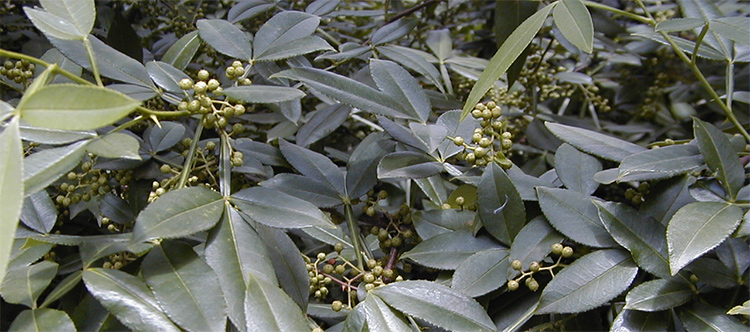Xanthoxylum Essential Oil
Zanthoxylum armatum / Zanthoxylum alatum / Xanthoxylum alatum

"Zanthoxylum alatum" (Cropped) by Cillas. Licensed under CC BY 2.0.
Description
Xanthoxylum Essential Oil, is also known as Zanthoxylum, Tomar, and Timur Essential Oil.

Xanthoxylum Essential Oil is an intriguing yet much lesser known essential oil. Very little has been written about it.
The essential oil is typically steam distilled from dried fruits that resemble peppercorns. Steffen Arctander mentions that Xanthoxylum is known as "Chinese Wild Pepper" in the Far East. He describes the aroma of Xanthoxylum Essential Oil as "warm, woody, green-peppery and spicy" and that is it has an aroma that is reminiscent to cubeb and guaiacwood. [Source: Steffen Arctander, Perfume and Flavor Materials of Natural Origin (Reprint Edition. Elizabeth, NJ: Pathfinder., 2017), 664.]
Xanthoxylum Essential Oil is abundant in linalol and limonene. It also contains about 6-10% of the ester methyl cinnamate which strongly contributes to the pleasantly fruity yet spicy aroma of the oil. The uses for Xanthoxylum Essential Oil are not well documented, but its composition of linalol and limonene may make the oil useful in anti-inflammatory, anti-microbial blends and blends intended to support emotional balance.
From a chemical standpoint, I find it interesting that Xanthoxylum Essential Oil shares some similarity to that of Neroli Essential Oil. For example, both oils share linalol compositions of approximately 35-40% and total monoterpenol compositions of about 45%. They also both contain about 15-20% limonene and share monoterpene compositions of about 35-40%. Their ester compositions are also somewhat similar. In no way do I mean to suggest that Xanthoxylum Essential Oil shares a smiliar aroma with Neroli Essential Oil (it doesn't), and the applications for each oil aren't the same. Neroli does tend to be comprised of more esters, particularly linalyl acetate. For example, I find Neroli Essential Oil to be much more calming. From personal experience, I find Xanthoxylum Essential Oil to be more of a balancing, adaptogenic oil. Xanthoxylum Essential Oil has been helping to improve my focus as needed while simultaneously providing a level of calm when needed. Your experience and results with the oil may be different. I recommend that you do more research into the oil and its composition to help you determine and verify the suitability of the essential oil for your particular needs.
In working aromatically with the oil, I find that it blends well with a wide array of essential oils especially those in the spice, citrus, wood and floral families.
Botanical Name of Xanthoxylum Essential Oil
Zanthoxylum armatum / Zanthoxylum alatum / Xanthoxylum alatum [Source: Robert Tisserand and Rodney Young, Essential Oil Safety (Second Edition. United Kingdom: Churchill Livingstone Elsevier, 2014), 455.]
Plant Family
Common Method of Extraction
Steam Distilled
Plant Part Typically Used
Color
Clear to Pale Yellow
Consistency
Thin
Perfumery Note
Top
Strength of Initial Aroma
Medium - Strong
Aromatic Description
Xanthoxylum Essential Oil smells sweet, fruity, woody and spicy.
Sustainability and Conservation Status
Least Concern
Source: https://www.iucnredlist.org/species/149660605/149822451
To learn more about the conservation status of essential oil bearing plants and how to use the IUCN Red List of Threatened Species, please refer to AromaWeb's Guide to Essential Oils and Sustainability.
Major Constituents of Xanthoxylum Essential Oil
- Linalol
- Methyl cinnamate
- (+)-Limonene
- B-Phellandrene
Source: N.C. Shah, Chemical Composition of the Percarp Oil of Zanthxylum armatum DC. (Journal of Essential Oil Research 3, 1991), 467-468. Source cited in Robert Tisserand and Rodney Young, Essential Oil Safety (Second Edition. United Kingdom: Churchill Livingstone Elsevier, 2014), 455.
Xanthoxylum Essential Oil Safety Information
Tisserand and Young do not indicate any special precautions when using Xanthoxylum Essential Oil. Reading Tisserand and Young's full profile is recommended. [Robert Tisserand and Rodney Young, Essential Oil Safety (Second Edition. United Kingdom: Churchill Livingstone Elsevier, 2014), 455.]
General Safety Information
Do not take any oils internally and do not apply undiluted essential oils, absolutes, CO2s or other concentrated essences onto the skin without advanced essential oil knowledge or consultation from a qualified aromatherapy practitioner. For general dilution information, read AromaWeb's Guide to Diluting Essential Oils. If you are pregnant, epileptic, have liver damage, have cancer, or have any other medical problem, use oils only under the proper guidance of a qualified aromatherapy practitioner. Use extreme caution when using oils with children and be sure to first read the recommended dilution ratios for children. Consult a qualified aromatherapy practitioner before using oils with children, the elderly, if you have medical issues or are taking medications. Before using this or any essential oil, carefully read AromaWeb's Essential Oil Safety Information page. For in-depth information on oil safety issues, read Essential Oil Safety by Robert Tisserand and Rodney Young.
Shelf Life
Important Information About the Profiles
The essential oil information provided on AromaWeb is intended for basic educational purposes only. The references to safety information, test results, constituents and percentages is generalized information. Essential oils can vary greatly in composition. The data is not necessary complete and is not guaranteed to be accurate. The essential oil photos are intended to represent the typical and approximate color of each essential oil. However, essential oil composition and color can vary based on harvesting, distillation, age of the essential oil and other factors. Profiles for several CO2 Extracts and absolutes are included within the directory, and are denoted as such.
